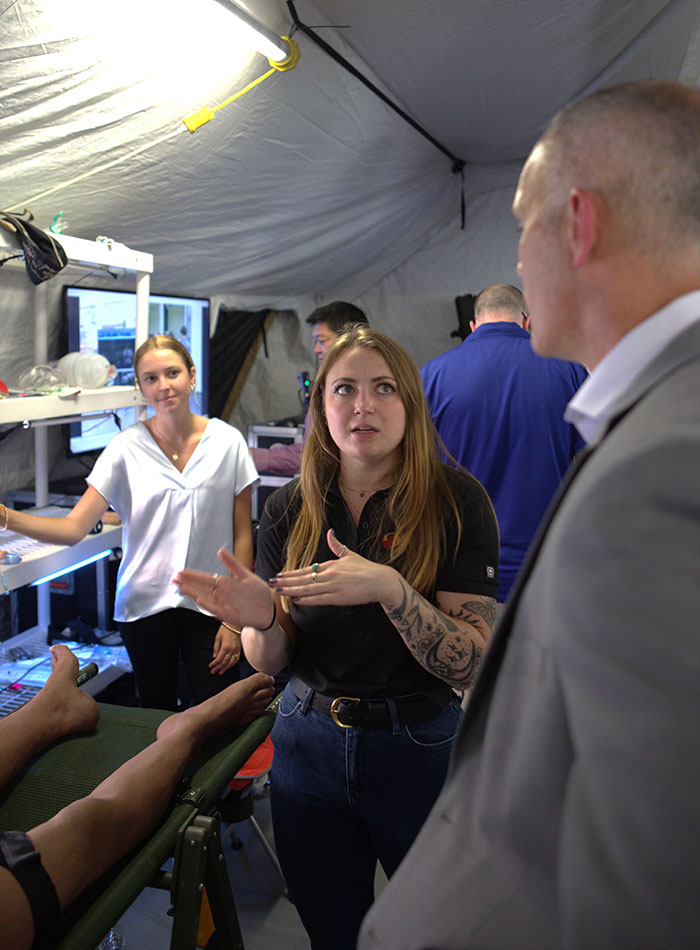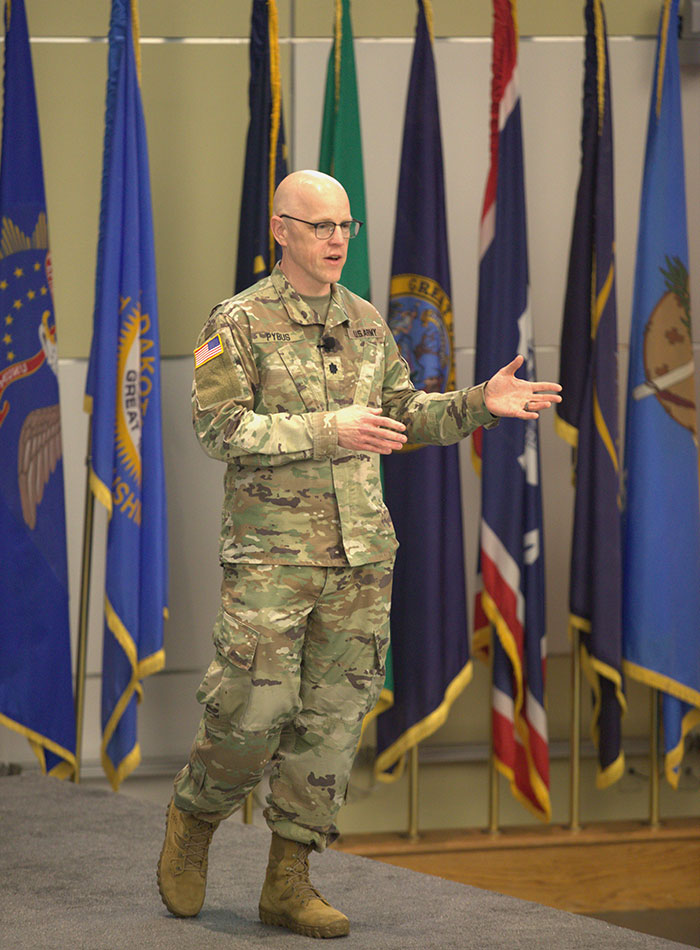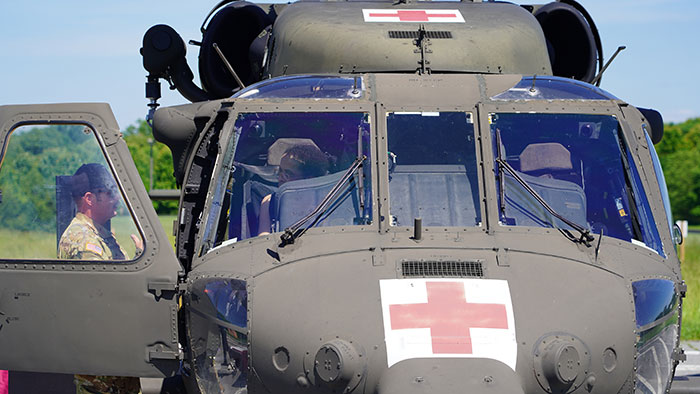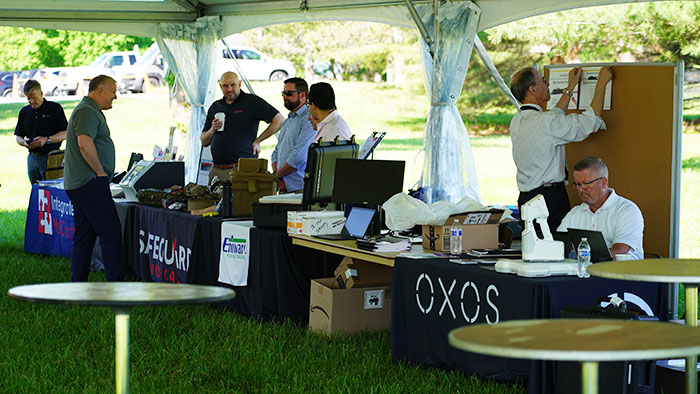USAMRDC 'Capability Days' Event Spotlights the Future of Military Medicine
FORT DETRICK, Md. — Over 200 attendees from across the Department of Defense, Congress and industry were treated to discussions and demonstrations of the next generation of military medical devices currently under development by the U.S. Army Medical Research and Development Command during the third annual Capability Days event, May 21-22 at Fort Detrick.
The two-day showcase featured hands-on demonstrations of innovative lifesaving devices and techniques, in-depth presentations and panel sessions, vendors and networking opportunities with senior leaders and subject matter experts from across MRDC. Attendees were able to observe medical technology demonstrations from each of MRDC's subordinate commands on display inside four TEMPER (Tent, Extendable, Modular, Personnel) air-supported shelters – developed by MRDC's Medical Materiel Development Activity – as well as examine up-close a Joint Light Tactical Vehicle and an HH-60M Black Hawk, both equipped for casualty evacuation.
"It's amazing what we do here," said Brig. Gen Ned Bailey, MRDC's commanding general. "From the benchtop to putting products in the hands of our Warfighters, we produce some amazing products. And we work with industry, we work with academia, we work with our foreign partners to make it happen. The things we develop frequently go out to the world at large. Some of our research has been responsible for hundreds, thousands, maybe millions of lives saved from malaria and other diseases."
Among the cutting-edge military medical technologies that attendees were able to see up close during the event were the Telerobotic Surgery Operative Network developed by MRDC's Telemedicine and Advanced Technology Research Center, which combines virtual reality with robotics to allow surgeons to conduct surgical procedures remotely; the Blast Overpressure Tool developed by the DOD Blast Injury Research Coordinating Office, which will help Service Members protect themselves during training from the effects of high-pressure shock waves created by heavy weapons and breaching charges; and a suite of multisensory cueing technologies developed by the Aeromedical Research Laboratory that will allow pilots to use sounds and touch to determine their spatial orientation when flying in low-visibility conditions.
Throughout the event, breakout sessions showcased a broad selection of innovative medical research being conducted at MRDC's subordinate commands across the country. For example, the Institute of Infectious Diseases discussed its new TREAT 525 platform, which uses monoclonal antibodies to combat immediate and emerging infectious disease threats. The Institute of Surgical Research shared how an innovative foam dressing uses embedded silver and cerium ions to protect burns against microbial infection. The Institute of Chemical Defense highlighted two new approaches to treat combined injuries involving trauma and chemical exposure in a prolonged field care setting.
Several other breakout sessions explored MRDC's robust product acquisition capabilities. For example, the Medical Research Acquisition Activity discussed specialized contracting vehicles such as the Broad Agency Announcement and Other Transaction Agreements to solicit proposals for scientific research and development projects and accelerate product development. The Office of Regulated Activities shared how inventors can bridge the regulatory gap to obtain FDA approval for new devices, drugs and biologics.
USAARL's Black Hawk helicopter flew from Fort Novosel, Alabama, and was among the most popular displays. Capable of carrying up to six litters and their accompanying medical equipment in a space not much bigger than the interior of a large SUV, the helicopter serves as a one-of-a-kind flying laboratory for testing medical devices in demanding real-world conditions.
Col. Matthew Hoefer, USAARL's commander, explained that data collected from experiments conducted in the helicopter can be correlated with data about the aircraft's performance at any given moment, so that researchers can precisely determine what effect variables such as atmospheric pressure, ambient temperature and even the aircraft's vibrations and attitude have on the experimental outcomes.
"This is the only aircraft in the Army that is used for air medical research," Hoefer said. "We think of it as an extension of our laboratory."
Research informed by real-world experience is vital for ensuring MRDC adapts to changing threats, said Dr. Mark Dertzbaugh, Principal Assistant for Research and Technology at MRDC. As the military pivots from focusing on responding to small-scale terror attacks by non-state actors to confronting the potential for theater-wide conflicts with near peers, so too must medical research and development adjust its focus to prepare for the unique needs of those types of operations.
"We're going back to the future in a way, thinking once again about how to clear mass casualties from a battlefield," Dertzbaugh said. "How do we deal with that? How do we process them if we can't get them back to definitive care quickly? How do we preserve their life out there and how are we going to get them back? Those are the themes that we're focused on."
Another overarching theme of this year's Capability Days was the completion of MRDC's organizational transition to the Defense Health Agency, a joint, integrated combat support agency whose mission is to provide the Army, Navy and Air Force with a medically ready force and a ready medical force. Bailey noted that the DHA's mission aligns well with MRDC's focus on research and development in support of the military's unique medical readiness requirements."
"With our transition to DHA, it's important that we maintain the connection between the initial concept for a product and what happens in every one of our laboratories to deliver that product," Bailey explained. "We have to make sure that we don't lose the linkage between somebody's good idea and our ability to get it into the hands of the Warfighter."


















